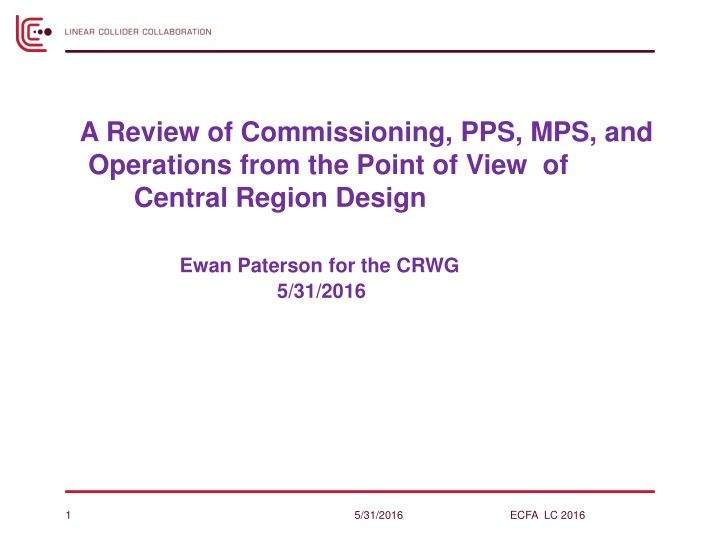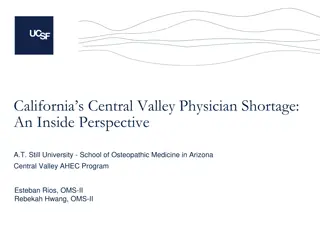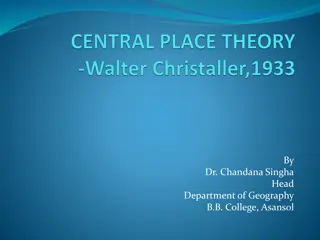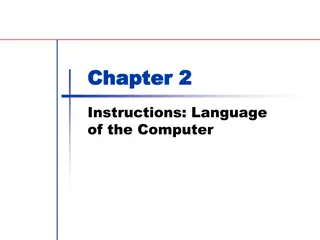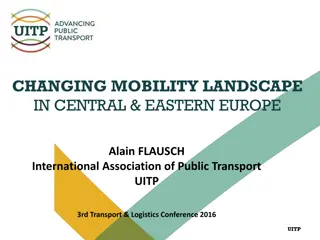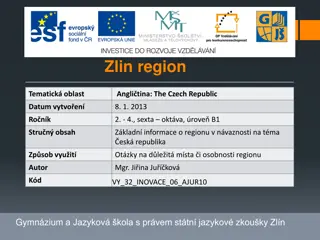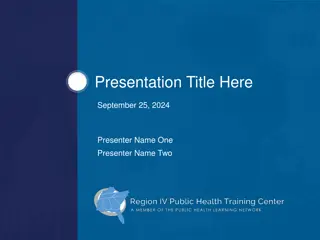Overview of Central Region Design and Operations
A review of commissioning, PPS, MPS, and operations from the perspective of Central Region Design by Ewan Paterson for CRWG. The document covers the beam commissioning process, assumptions, stages, schematic, and impacts on Central Region Design and Operation.
Download Presentation

Please find below an Image/Link to download the presentation.
The content on the website is provided AS IS for your information and personal use only. It may not be sold, licensed, or shared on other websites without obtaining consent from the author.If you encounter any issues during the download, it is possible that the publisher has removed the file from their server.
You are allowed to download the files provided on this website for personal or commercial use, subject to the condition that they are used lawfully. All files are the property of their respective owners.
The content on the website is provided AS IS for your information and personal use only. It may not be sold, licensed, or shared on other websites without obtaining consent from the author.
E N D
Presentation Transcript
A Review of Commissioning, PPS, MPS, and Operations from the Point of View of Central Region Design Ewan Paterson for the CRWG 5/31/2016 1 5/31/2016 ECFA LC 2016
Beam Commissioning Strawman Model Assumptions The construction and installation schedules will be planned with the following region by region beam turn on and commissioning schedule as the goal. Any hardware installation, checkout or processing in each tunnel region has been completed before commissioning. For example before one commissions the E- Injector, the E+ BDS hardware which shares the same section of tunnel should have been installed. Only the Undulater Positron production system without the use of an auxiliary source is considered. A fully self shielded detector with instrumentation is in place before BDS tuning begins in stages 7 and 13, see next slide. 2 5/31/2016 ECFA LC 2016
REGION by REGION BEAM COMMISSIONING ELECTRON BEAM STAGES (1) E- Injector thru booster end at 5 GeV (2) Transport to E- DR INJ thru energy compressor (3) E- DR to DR- Extraction (4) E- Extraction thru RTML to Compressors Linac start (5) E- Bunch Compressor to E- Linac End (6) E- Thru Undulator to BDS E- dump. (7) BDS Dump thru IR, detector to Main E- Dump POSITRON BEAM STAGES Starting in parallel with 7) (8) E+ Source to (missing dump) after booster. (9) E+ Transport to E+ DR Injection thru energy compressor and spin rotator. (10) E+ DR to DR Extraction (11) E- Extraction thru RTML to Compressors at Linac start. (12) E+ Compressors to Linac End and BDS E+ dump (13) BDS dump thru the IR, detector to Main E+ Dump (14) Collide Beams and Tune all systems with beams to main dumps. 3 5/31/2016 ECFA LC 2016
Schematic of Commissioning Mode Blue arrows indicate stages with E- and Red the E+ (10) (2) (3) (4) (1) (5) (8) (6) (7) (11) (13) (12) (9) 4 5/31/2016 ECFA LC 2016
Impacts on the Central Region Design and Operation Each region being commissioned terminates in a Tune-up Dump capable of handling a Beam Power consistent with the maximum level foreseen for that location even after upgrades. These dumps are also used by the Machine Protection abort systems. Most of the dumps are in the Central Region and have a considerable impact on CFS designs. In the TDR they are The exact location and power level for these dumps is under review in the CRWG. Although during early commissioning one can operate at lower power levels, the above levels appear to be necessary for tuning at full power without limiting the exploration of performance of some system. 5 5/31/2016 ECFA LC 2016
IMPACT OF MPS ON CRWG/CFS STUDIES The MPS is a complex and critical system! There is a lot of detail design work required in the future but the impact on the CRWG studies is limited today to :- The fixing of the tune-up dumps power levels, their exact location, their support services and shielding of residual radiation. A review to check that the E- Gun, Injectors, and DR s have adequate flexibility to satisfy the MPS requirements such as having low charge (1%) probe bunch followed 10 sec later by a normal bunch train and a very flexible ramp up in bunch intensity, train length and even repetition rate. Ensure that the design lattice includes adequate space for kickers that are part of the MPS and share the tune-up dumps in this region. Consider whether any additional abort locations are needed, e.g. end of E- linac verses the end of the undulator or perhaps along the linacs. 6
PPS and Central Region Design The PPS Design has to :- To satisfy radiation control during commissioning and operation in both beam and service areas. To have sub-zones to make access and/or search functions as efficient as possible. To be modular and allow installation and commissioning schedules. To allow emergency egress for personnel and be consistent with ventilation of tunnels in both normal and emergency conditions. To allow for special local conditions of high residual radiation around the E+ source and high power dumps. These latter items in green have a more immediate impact on the questions surrounding tunnel size, Twin or Kamaboko tunnels and 1.5 m thick shielding walls. 7 March 1, 2016 JMP
Discussion Can we continue with a 1.5 m shield wall from the end of the Linac to the DR or IR. The warm RF E+ Capture sections and the Cold Booster 5 GeV Linacs can be sources of dark current and radiation without beam. Can we mitigate this with either special shielding or magnetic fields? How realistic is the Strawman Schedule ? See the next slide? Between each stage of the schedule there would be a brief pause as one modified and recertified the PPS and MPS safety systems. There would be no beam available during this Few Day period and Inter-connects between systems in either beam or support tunnels would be completed. Is there enough to be gained to justify an Auxiliary Source for E+? Some temporary PPS would be used in the Linac and Support tunnels prior to Beam Commissioning to allow for RF processing of linac modules. 8 5/31/2016 ECFA LC 2016
Strawman Schedule using Only Undulator E+ Source ELECTRON BEAM STAGES (1) E- Injector thru booster end at 5 GeV ... .4 (2) Transport to E- DR INJ thru energy compressor ....... .2 (3) E- DR to DR- Extraction .....8 (4) E- Extraction thru RTML to Compressors Linac start 2 (5) E- Bunch Compressor to E- Linac End ... 3 (6) E- Thru Undulator to BDS E- dump. ... .2 (7) BDS Dump thru IR, detector to Main E- Dump ... 6 POSITRON BEAM STAGES Starting in parallel with 7) (8) E+ Source to (missing dump)? after booster. ..... 6 (9) E+ Transport to E+ DR Injection thru energy compressor and spin rotator....2 (10) E+ DR to DR Extraction 7 (11) E- Extraction thru RTML to Compressors at Linac start. .2 (12) E+ Compressors to Linac End and BDS E+ dump .4 (13) BDS dump thru the IR, detector to Main E+ Dump ... 4 (14) Collide Beams and Tune all systems with beams to main dumps. ? WEEKS 52+ WEEKS 9 5/31/2016 ECFA LC 2016
